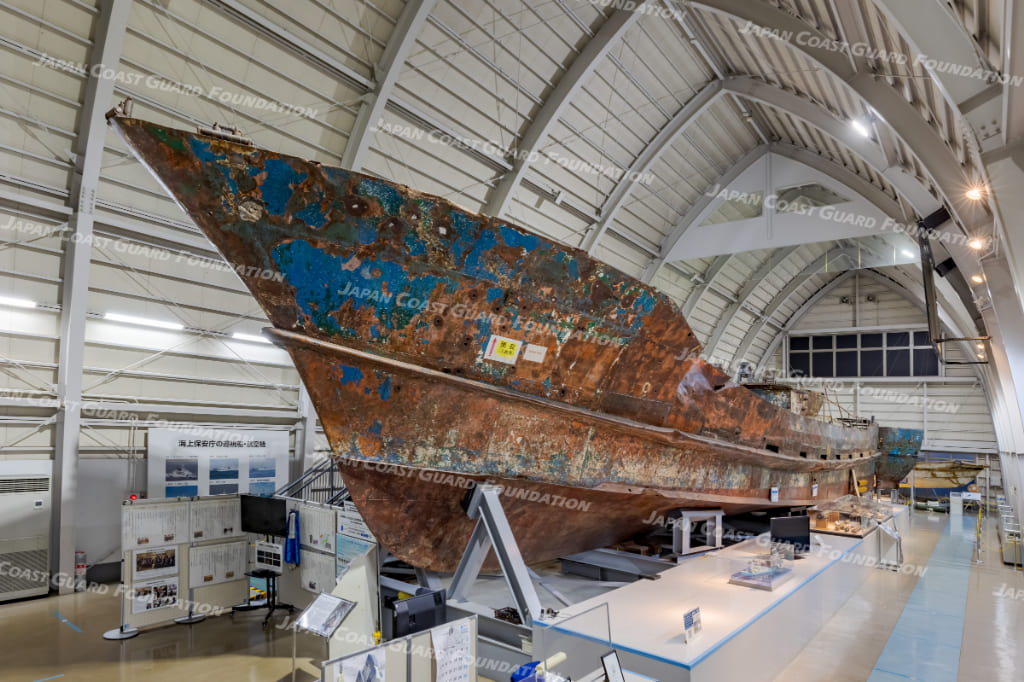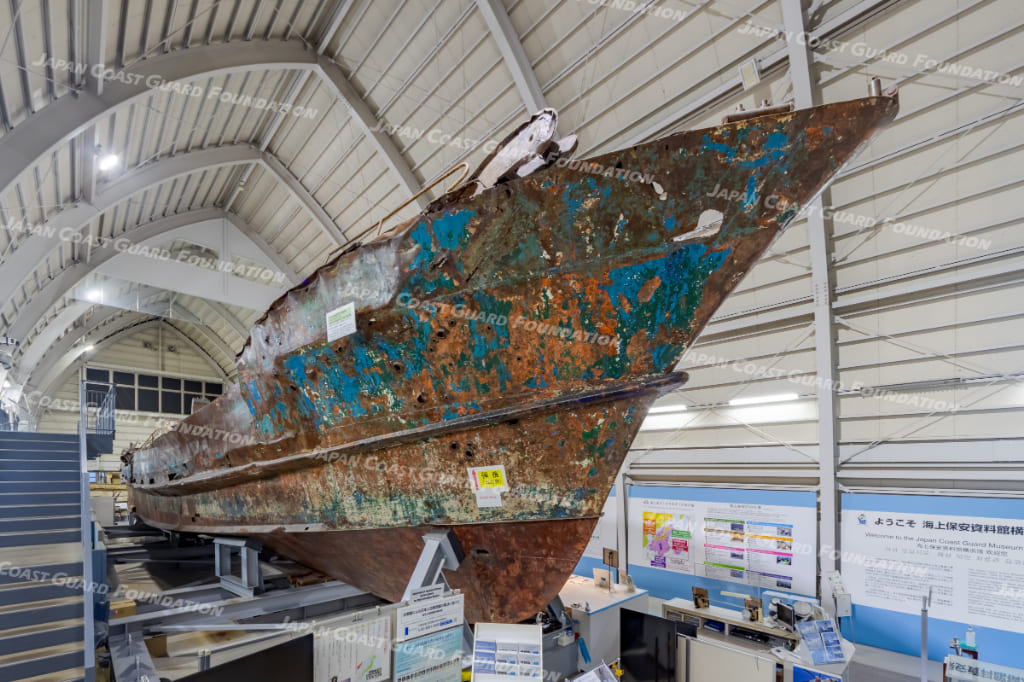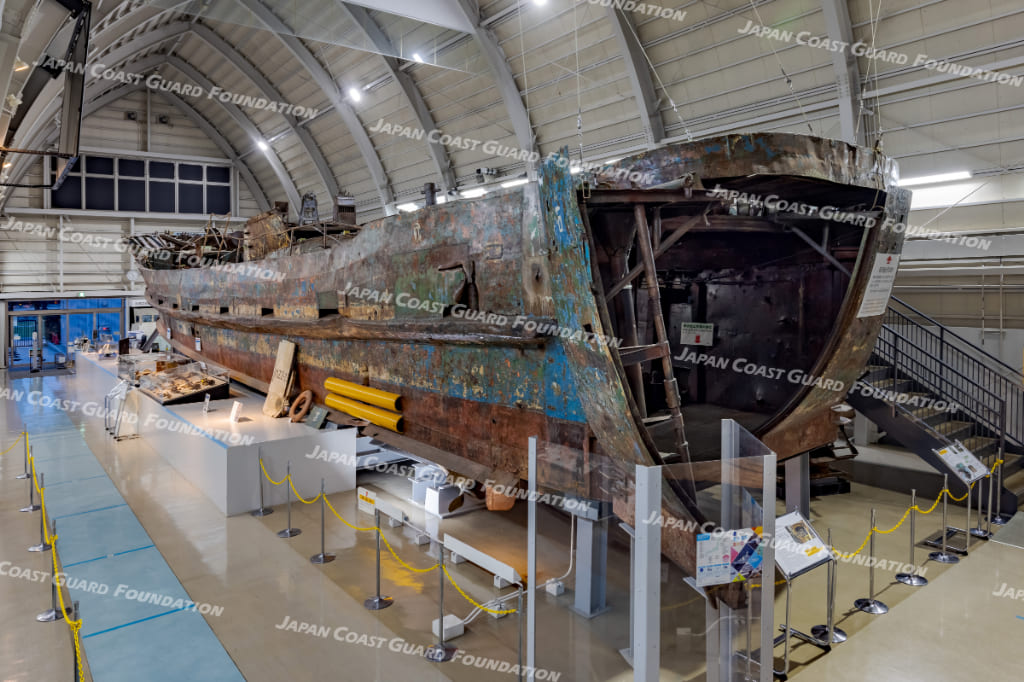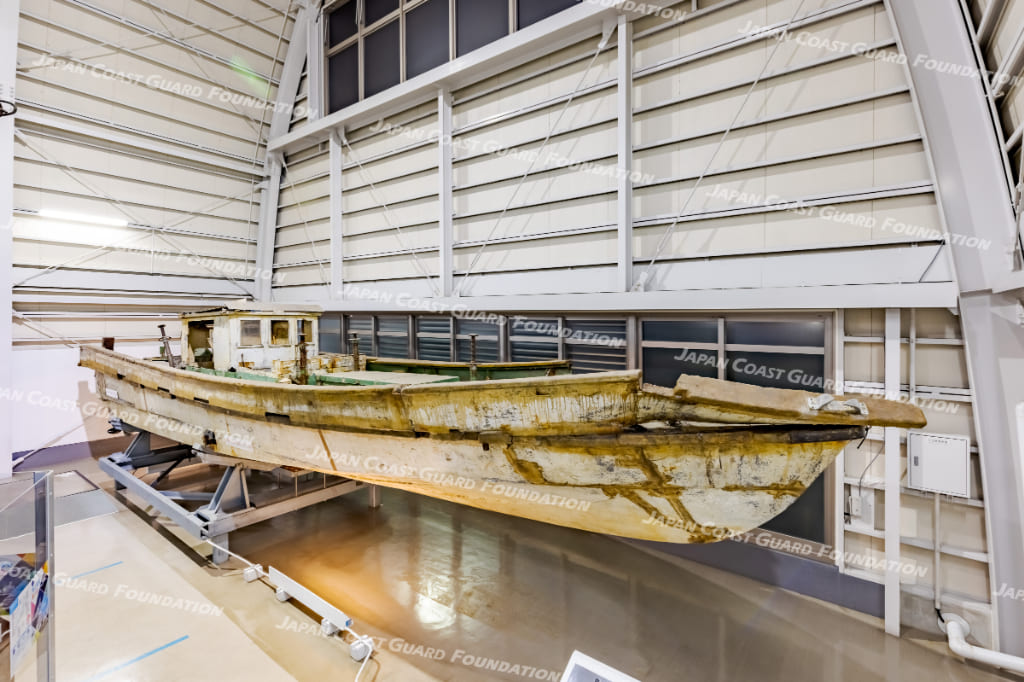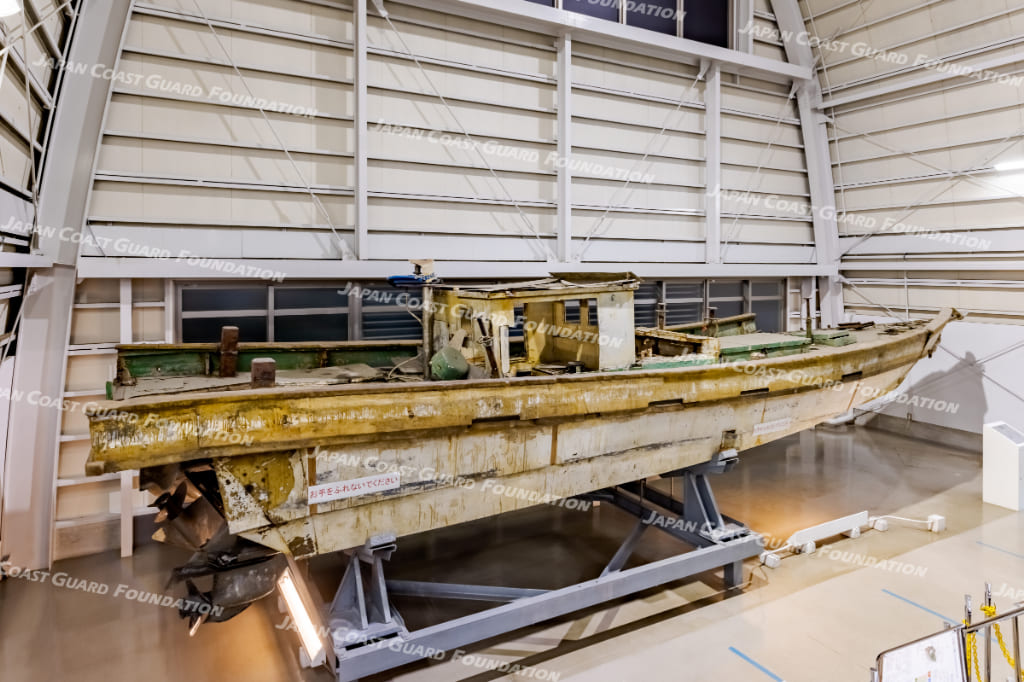Spy Ship
【Details of the Spy Ship】
The spy ship was 30 meters in length overall and 5 meteres in width, fitted with four three-winged fixed pitch propellers in a row on its bottom. Each outer propeler has a rudder behind it. As the ship had a unique structure, these four propllers were led through long shafts to four engines in two each in the fore and aft engine rooms.
The bridge, which remained to lie on the seabed when the hull was raised, was recovered later. It was then found out that the bridge roof was made of steel, while the side panel with a porthole was made of wood (plywood).
The bow was similar to an old model of a long-liner or a round-haul netter (fishing boat). However, the shape below the draft line was vastly different from a fishing boat and had a V-shaped hull, suited for high-speed navigation. The stern hull was made up of left-right hinged double hatches being openable by an air cylinder, inside which a small boat was stored. These stern hatches had rubber packings to secure water tightness.
A post equipped at the upper part of the stern, which the crew can manipulate by hand, maintains the hatches open once they are opened. The left hatch is locked together with the right hatch by wedge-shaped hardware at the lower end of the outer side by turning a screw-in steel pipe installed inside by hand.
An iron frame was attached to the stern to allow the ship to disguise the ship’s registration by inserting a fake ship registration plate into the frame.
The outer panels were significantly thinner than those of Japanese fishing boats, and the distance between the frames (steel frames supporting the outer hull) was narrow. Therefore, the spy ship is considered a special vessel built for special purposes and missions and not a vessel modified from an ordinary Japanese fishing boat that had been exported.
【Inboard Layout of the Spy Ship】
From the bow of the upper structure of the spy ship was the bridge, the cabin where cooking and others were done, and the storage compartment for a 14.5 mm anti-aircraft machine gun. There was little space to live inside, so all the crew (at least 10 confirmed to have been aboard) most likely lived in the tiny upper structure of the ship, including the bridge, where they could take naps and cook.
In the main hull below the upper deck, there were, in the bow section, a void space and permanent ballast; behind it, a void space and several fuel tanks; between the bow section and the bridge (the center), the first (fore) and the second (aft) engine room; and from the center to the stern, a small boat storage compartment, fuel tanks, and ballast tanks.
On the upper deck in front of the engine room was a well (an under-floor storage compartment) where some weaponry (presumably a 14.5 mm anti-aircraft machine gun) is presumed to have been installed in the past. It is thought that high-pressure air was led to the floor of the well, and the weapon was able to move up and down to the upper deck along four vertical rails, two each on the front and the rear walls of the well. At the time of the sinking, the well was not equipped with weapons but was used to store a rubber raft and other equipment instead.
Behind the engine room is a “small boat storage compartment” and its forward-most part has a structure that extends into the second engine room at the center to store the bow part of a small boat. The aft end of the small boat storage compartment is the ship’s stern, and the stern has the left-right double hatches for loading and unloading the small boat.
Both sides of the small boat storage compartment were installed with fuel tanks, and the bottom side was equipped with ballast tanks. Above the fuel tanks, four temporary tanks for the small boat were installed.
Vessel Name: Changyu 3705
LOA: 29.68m
Width: 4.66m
Depth: 2.30m
Gross Tonnage: 44 tons (approx. 55 tons in weight)
Main Engine: Four Russian-Made High-Speed Diesel Engines.
Output: Maximum Continuous Output Approx. 4,400 HP (total of 4 engines)
Propulsion: Four 3-Winged Fixed Pitch Propellers
Speed: Approx. 33 knots / approx. 60 km/h (at Continuous Maximum Power)
Cruising Range: 1,200 NM / approx. 2,200 km (at Continuous Maximum Power)
Small Boat
The small boat was stored in the compartment inside the left-right double hatches of the ship’s stern (small boat storage compartment).
The boat was 11.21m in LOA, 2.5m in width, and 0.95m in depth. Its hull was made of FRP (partially made of wood), and the upper deck of the hull was made of wood painted dark green. The bridge near the hull’s center had a single rudder wheel and three throttle levers.
The small boat was clevery designed with equipment and ingenuity to be stored in the spy ship and disguise a small fishing boat to approach shallow-water coastal areas from the spy ship offshore. The bridge, masts, and a radar are either elevatable or detachable. The equipment for disguising is three masts, one mast light, one navigation light, seven lights for squid fishing boats (stored in the bow storage), and a shielding curtain to hide the three propellers.
Unlike ordinary fishing boats, the boat’s bottom is a V-shaped hull form like the spy ship suitable for high-speed navigation and is estimated to sail at 30 knots (about 55 km/h) and more.
The boat had an underwater scooter onboard, presumably for landing, in a storage compartment in the center of the hull, as well as navigational instruments including a radar (made in Japan, with an elevatable antenna), a magnetic compass (made in Japan), and a GPS plotter (made in Japan, with an elevatable antenna attached to the bridge).
The boat’s structure can accommodate up to four people in the bridge and up to six people in the two void spaces in the hull’s bow, for a maximum of ten people.
LOA: 11.21m
Width: 2.5m
Depth: 0.95m
Draught: 0.50m
Gross Tonnage: 2.9 ton (Weight: approx. 6 tons in weight)
Main Engine: Three Swedish Gasoline Inboard / Outboard Engines
Output: Approx. 900 HP (total of 3 Engines)
Propulsion System: Outdrive
Propulsion: Three 3-Winged Fixed Pitch Propellers
Maximum Speed: Approx. 50 knots / 90 km/h
Cruising Range: Approx. 150 NM / 280 km (at 50 knots)
